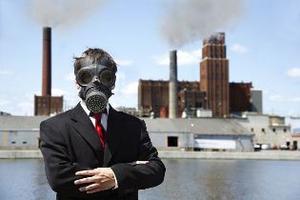Water securityProtecting U.S. water supplies
Aside from possible cyberatacks on water utilities, security officials are worried that terrorists could contaminate water supplies with volatile chemicals that can poison thousands of individuals and even cause explosions; DHS warned local water utilities of “backpressure” — a simple tactic terrorists could use to introduce a chemical or biological agent into the water supply and spread it over long distances without immediate detection

Physical water supply attacks can be more deadly than cyberattacks // Source: uaprom.net
Aside from possible cyberatacks on water utilities, security officials are worried that terrorists could contaminate water supplies with volatile chemicals that can poison thousands of individuals and even cause explosions.
In August 1982, 500 residents in New England were ordered to evacuate their homes after reports of bubbling and hissing from toilets and faucets as well as two explosions. A mixture of propane and water had seeped into the town’s water supply, causing a volatile reaction in hundreds of homes.
The incident was not an intentional attack, but security officials fear terrorists could just as easily exploit the U.S. water system to create havoc.
In a recent security bulletin, DHS and the Interagency Threat Assessment and Coordination Group warned local water utilities of a simple tactic terrorists could use to introduce a chemical or biological agent into the water supply and spread it over long distances without immediate detection.
“Over the last decade, violent extremists have expressed aspirational interest in contaminating unspecified water supplies, and as recently as July 2011 specifically raised backpressure as a means of contamination,” the bulletin said.
Backpressure occurs when the normal flow of water systems reverse with the water collecting contaminants as it flows backwards.
“Backpressure happens when there is a pressure, higher than the city water pressure, exerted on the water systems and it causes the water to flow backward,” explained Roy Dillard, the director of the American Backflow Prevention Association.
According to Dillard, backpressure is a relatively common phenomenon.
“When you lose pressure in the public water system, like if a water main breaks, anything that is in that line will get siphoned back into the water line…so it’s not an uncommon thing,” he said.
In the 1982 case of the propane and water mixture, repairmen had connected an industrial propane tank to a fire hydrant in an attempt to purge the defective tank before starting repairs. Due to the tank’s higher pressure, propane vapors were inadvertently forced into the pipes and contaminated the entire town’s water supply.
DHS officials fear that terrorists could cheaply and easily launch a malicious attack using backpressure, but experts say that while backpressure attacks are a potential threats, existing safety measures should be enough to thwart a potential attack.
“It’s possible. Virtually any kid taking a high school science class could figure it out, but it would have to be done in such volumes that it would be relatively hard to do because of the fact that we use backflow prevention assemblies in major areas and almost all of your industrial areas,” Dillard said.
Meanwhile if terrorists tried to use a biological agent, Dillard said the chlorine in tap water should be enough to nullify it.
“That’s what we keep the chlorine for, to keep the nasties out. It also keeps dysentery and cholera out of our water systems,” he said.
Dillard added that all fifty states have required the use of controlled cross-connections and backflow prevention systems, while thirty-two states have active backflow prevention programs.
“Our water systems are pretty well protected,” Dillard concluded.
